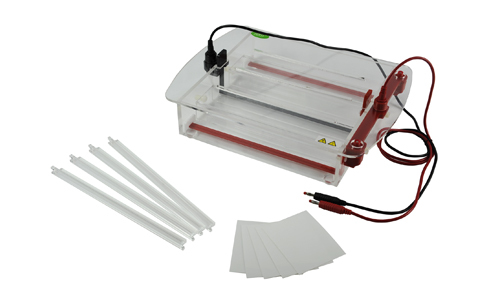Electrophoresis is an analytical method in which a controlled electric current is used in order to separate biomolecules according to their size-to-electric charge ratio, using a jellylike matrix as the basis. This technique has a variety of practical uses, including forensic medicine for human identification, the human genome project, research for proteins and genetic mutations, and clinical diagnostic tests.
Which equipment is used in this technique?
Electrophoresis is done with a kit composed of a negative charge at one end and a positive charge at the other, called the electrophoresis system. When you insert charged molecules, in this environment, the negative ones go to one end and the positive ones go to the other corresponding. For example, when protein is analyzed in a gel, in these kits, the entire protein is taken to test for size. This way, the shorter ones will migrate to the poles more quickly and will be reflected at the bottom of the gel. However, the longest ones will be at the top.
How does it work?
When a mixture of ionized and net charged molecules are positioned in an electric field, they undergo an attraction force toward the opposite charged pole, allowing time for the positively charged molecules to move toward the cathode (negative pole) and the positively charged molecules to move toward the anode (positive pole).
Electrophoresis is a common technique in the clinical laboratory. It allows separating chemical species (nucleic acids or proteins) along an electrical field depending on their size and electrical charge.
Some types of electrophoresis
Electrophoresis in filter paper and cellulose acetate: Electrophoresis with filter paper as a backing is rarely used, and its use is reduced to the separation of amino acids. In contrast, electrophoresis in cellulose acetate, or cellulose, has a number of advantages over filter paper. Enables protein separation, faster migrations, and higher resolution
Agarose gel electrophoresis: Agarose gel is a good electrophoretic support. In addition, its nature gives it the characteristic of being able to separate molecules according to their size. This support allows separating nucleic acids according to their size. It’s used to separate large molecules.
Polyacrylamide gel electrophoresis: Polyacrylamide gel is considered the best support. In addition, they are highly mechanically stable and water insoluble. One drawback among the many advantages is that it is limiting its use: it is neurotoxic. It is used for the separation of proteins and, like agarose gel, it allows the separation of molecules according to their size.
Capillary electrophoresis: This technique differs considerably from previous techniques. The support is different because it uses fused silica capillaries, covered with a layer of polymine. The display of the results is done through a computer screen.
At Kalstein we are MANUFACTURERS, that is why you can BUY excellent electrophoresis systems for your laboratory at the best PRICES. That’s why we invite you to take a look at our equipment available in the HERE

